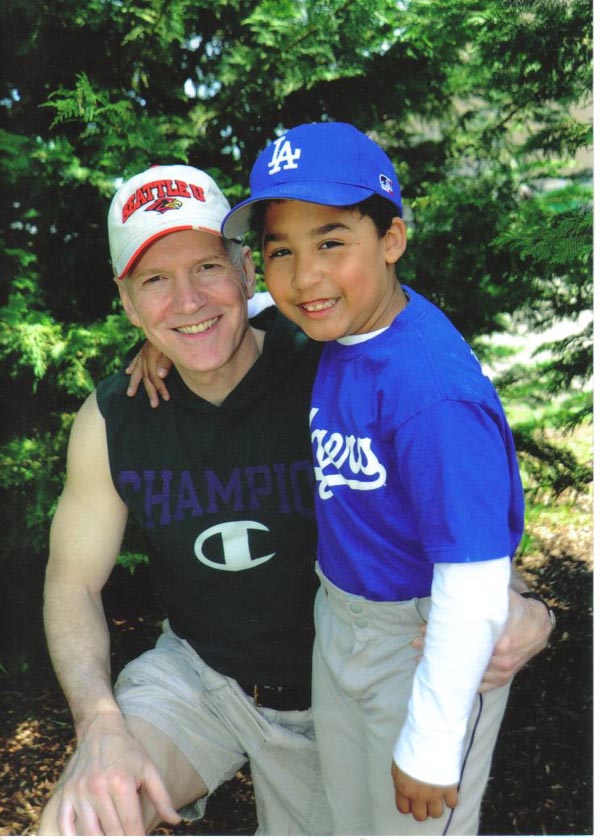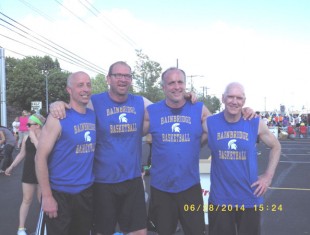Clay Moye and son Caleb
I’ve been spending some time working with three girls on their individual basketball skills on a local outdoor covered court and continue to be pleasantly surprised by what a good learning experience it is for me as well.
The girls are 12, 13 and 17 years old and although I never really thought I would enjoy working on basketball skills with girls that age they are very eager to improve, and I’ve discovered that I enjoy helping them work on their games.
I sort of fell into the role as a result of an intention to help my own daughter improve her basketball skills over a year ago, but she decided she didn’t want to play any longer.
At that point, I decided I should go ahead and continue to work with the girl who’d been showing up consistently. She’ll play on the local high school varsity team this coming season. The two younger girls recently joined our training sessions.
Over the past couple of years, I’ve come to understand that in terms of basketball there are many fundamental skills I perform unconsciously and take for granted, and that I need to become aware of them if I’m going to more successfully teach kids how to play the game.
For example, just this past week I discovered I needed to teach kids how to properly catch the basketball, even at these ages. That hadn’t occurred to me before.
Here’s how this revelation came about:
I like to use a little drill where I stand under the basket and have the kids move around the court 10 to 12 feet away from the basket while I pass them the ball. I teach them to bend their knees and dip slightly just before catching the ball so they can immediately come up and shoot it as opposed to dipping their knees and coming back up to shoot AFTER they’ve caught the ball. It helps them get their shot off quicker.
When doing this with the 12-year-old I immediately noticed she was shooting the ball with two hands, much like an old-timer might have launched a two-hand set shot back in the day.
At first, I couldn’t understand why she was doing that because we’d just worked on shooting form and she’d been shooting the ball properly with her right hand behind the ball and the left positioned on the side as a guide.
So, I spent some more time watching what she was doing and then I had her pass me the ball and tried to figure out what we were doing differently. Finally, it occurred to me that she was catching the ball with her hands on the sides of the ball while I caught it with my right hand behind the ball and my left hand on the side of the ball.
In essence, I catch the ball with my hands in the same position they’re in when I go to shoot the ball, while she catches the ball with her hands differently than they should be when she shots it properly.
So, when we ran this particular drill she tried to get her shot off quickly as I instructed and just shot it with her hands on the sides of the ball, thus two-handed.
Now, you might think that would be very unusual, that you wouldn’t have to teach very many kids how to properly catch the ball so their hands will be in the proper position for shooting it. But when I shared this revelation with a former high school teammate of mine, he realized he’d suffered from the same problem all throughout high school and it was the very reason his shooting form was so goofy.
He’d been accused of shooting two-handed at times in the eighth and ninth grades, but apparently nobody ever picked up it was because he was catching the ball and picking it up off the dribble improperly.
He was never taught how to catch the ball correctly. Instead, as he got older, he compensated for the problem by bringing the ball up overhead to shoot by rotating it all the way over to the left side of his head so his right hand would be behind the ball and his left hand underneath it while his elbow pointed outward to the side.
As a result, he shot the ball with a strange looking sideways spin on it.
That’s just one example of many little things I’ve come to understand I need to watch for and instruct these kids about as we continue to work together.
I’m actually finding it pretty fascinating to gain a better understanding of so many things I just learned to do unconsciously as a result of practicing and playing basketball so long.
Meanwhile, as I continue to read articles on-line or in Sports Illustrated and other periodicals, I realize just how much the success, or lack thereof, in so many other areas of athletics is based on circumstances outside the control of the participant.
By that, I mean in terms of things like when parents decide to start a boy in school, thus making him either one of the younger boys in his class or one of the older boys, and the potential impact that can have on their success as a result of their physical and emotional maturity in comparison with their counterparts.
Or, the type of coaching they receive. I think of the local youth leagues we have in our area for baseball and basketball for example and the processes that are in place for dividing the kids up for the various teams. It really is a crapshoot in terms of what coach a kid will end up with in most cases and the variance in the quality of coaching they will receive as a result can be huge.
Long ago, as I transitioned from a role in business from operations to becoming the director of quality for a time in one of the companies I have worked for, I came to understand the concept that all work is a process, a series of steps that produce a result. The only way to consistently produce a quality result is to have a thorough understanding of your process in terms of all the input and output requirements for each step in the process and then ensure those requirements are all being met without fail.
It occurred to me a long time ago that is really true in other facets of our lives as well, including athletics.


